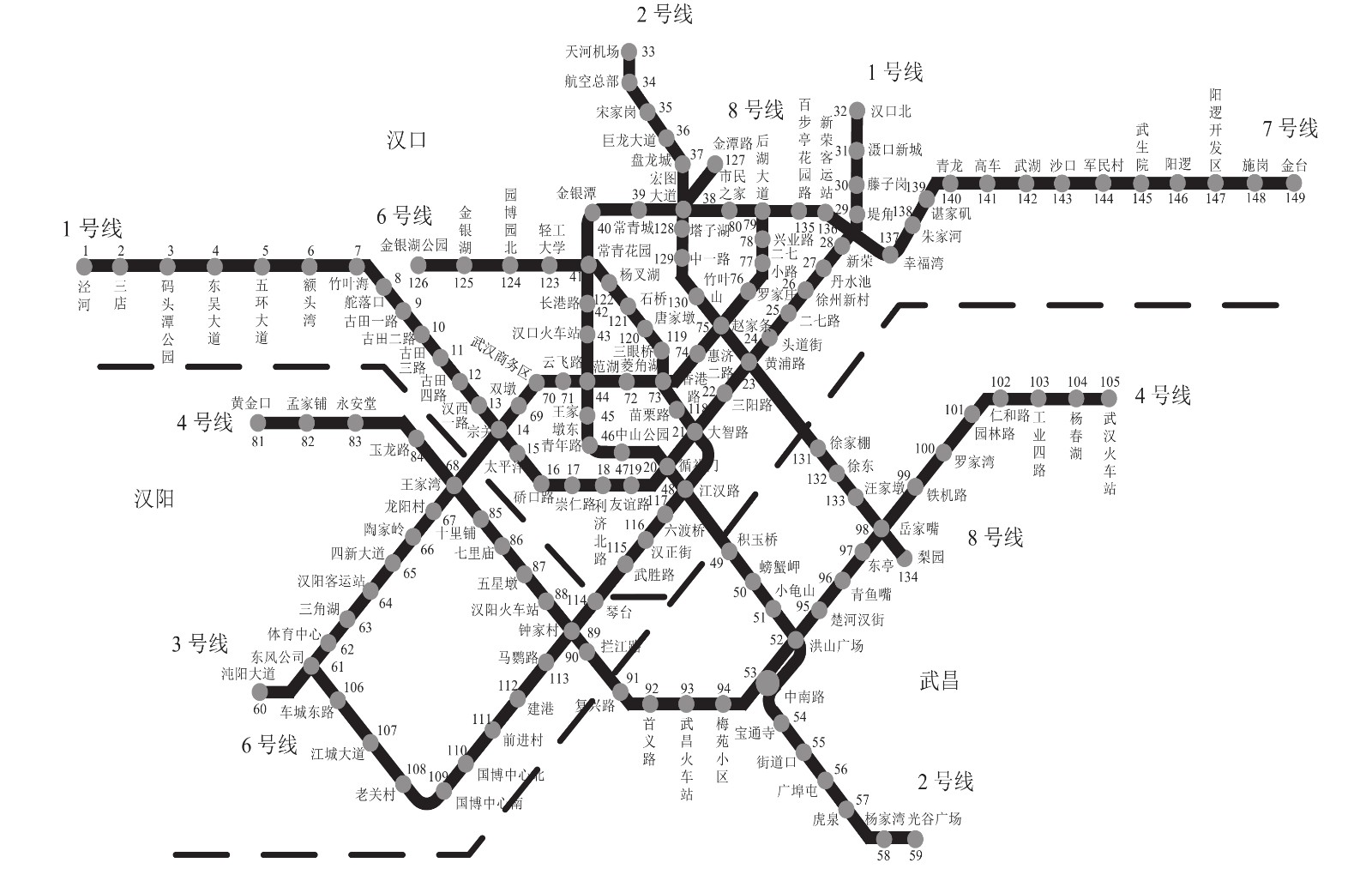Reliability and Service Quality Evaluation for Urban Rail Transit Network
-
摘要: 为评估区间通过能力下降对城市轨道交通网络可靠性和运输服务质量的影响,首先,以区间通过能力下降前后乘客的相对广义出行费用确定乘客的出行是否可靠,并以出行可靠的乘客占比评估网络的可靠性;其次,以乘客的平均广义出行费用评估网络的运输服务质量,采用基于改进Logit模型的随机用户均衡配流模型计算乘客的广义出行费用,并通过MSWA (method of successive weighted averages)算法求解该模型;然后,通过区间影响的乘客占比、区间介数分别识别网络的重要区间;最后,以武汉地铁为例分析重要区间通过能力下降后的网络可靠性和运输服务质量. 仿真结果表明:受区间影响的乘客占比识别的重要区间对城市轨道交通网络的可靠性和运输服务质量产生重要影响;重要区间多与换乘站直接相连,并且各重要区间能影响网络中12.24%~13.96%的乘客;为保证武汉地铁网络可靠性高于0.95,网络最多能容忍区间介数识别的3个重要区间的能力下降20%,或区间影响的乘客占比识别的1个重要区间的能力下降20%;随着下降区间数目和下降比例的升高,网络的可靠性持续下降,但网络的运输服务质量下降的情况会有所减弱.Abstract: To evaluate the impact of carrying capacity reductions on the reliability and service quality of an urban rail transit network, firstly, the generalized travel cost before and after capacity reductions was used to determine whether passengers’ travel was reliable. The network reliability was evaluated based on the fraction of reliable passengers whose travel was reliable. Secondly, the transportation service quality was evaluated based on the passengers’ average generalized travel cost, which was computed with the stochastic user equilibrium model based on an improved Logit model. The model was solved with the MSWA (method of successive weighted averages) algorithm. Then, the critical sections were identified with the fraction of passengers affected by sections and sections’ betweenness, respectively. Finally, a case study of Wuhan metro network was conducted to analyze its reliability and transportation service quality after carrying capacity reductions occur in the critical sections. The results show that the reliability and transportation service quality of this urban rail transit network are affected by critical sections identified with the fraction of the passengers affected by sections. Most of the critical sections are connected to transfer stations and each of them can affect 12.24%−13.96% of all passengers in the network. To ensure the reliability of Wuhan metro network exceeds 0.95, the network can tolerate at most a 20% decrease in carrying capacity at the three most critical sections identified with their betweenness, or a 20% decrease in carrying capacity at one critical section identified with the fraction of passengers affected by sections. As the number and fraction of capacity reductions increase, the reliability of the network continues to decline, but the reduction rate in transportation service quality gradually decreases.
-
表 1
Be 和Ie 分别识别的5个重要区间Table 1. Five most critical sections identified with
Be andIe respectively排序结果 区间介数 区间影响的乘客占比 区间 Be/% 区间 Ie/% 1 香港路—惠济二路 18.40 大智路—苗栗路 13.96 2 惠济二路—赵家条 18.22 循礼门—江汉路 13.66 3 香港路—苗栗路 11.95 循礼门—大智路 13.63 4 百步亭花园路—后湖大道 11.77 江汉路—大智路 13.41 5 循礼门—大智路 11.55 宗关—王家湾 12.24 -
陶骏杰,张勇. 多方式交通网络的时间可靠性分析[J]. 交通运输系统工程与信息,2015,15(2): 216-222. doi: 10.3969/j.issn.1009-6744.2015.02.033TAO Junjie, ZHANG Yong. Time reliability analysis of multi-modal transportation networks[J]. Journal of Transportation Systems Engineering and Information Technology, 2015, 15(2): 216-222. doi: 10.3969/j.issn.1009-6744.2015.02.033 JENELIUS E. Network structure and travel patterns:explaining the geographical disparities of road network vulnerability[J]. Journal of Transport Geography, 2009, 17(3): 234-244. doi: 10.1016/j.jtrangeo.2008.06.002 吕彪,刘一骝,刘海旭. 协同考虑脆弱性与可靠性的城市道路网络设计[J]. 西南交通大学学报,2019,54(5): 1093-1103.LYU Biao, LIU Yiliu, LIU Haixu. Urban road network design with balance between vulnerability and reliability[J]. Journal of Southwest Jiaotong University, 2019, 54(5): 1093-1103. TAYLOR M A P. Remoteness and accessibility in the vulnerability analysis of regional road networks[J]. Transportation Research Part A:Policy and Practice, 2012, 46(5): 761-771. doi: 10.1016/j.tra.2012.02.008 WANG Z, CHAN A P C, YUAN J, et al. Recent advances in modeling the vulnerability of transportation networks[J]. Journal of Infrastructure Systems, 2014, 21(2): 06014002.1-06014002.9. JIANG C Z, WU L, XU F, et al. Characteristics and reliability analysis of the complex network in Guangzhou rail transit[J]. Intelligent Automation & Soft Computing, 2013, 19(2): 217-225. 乔珂,赵鹏,姚向明. 城市轨道交通网络性能分析[J]. 交通运输系统工程与信息,2012,12(4): 115-121. doi: 10.3969/j.issn.1009-6744.2012.04.016QIAO Ke, ZHAO Peng, YAO Xiangming. Performance analysis of urban rail transit network[J]. Journal of Transportation Systems Engineering and Information Technology, 2012, 12(4): 115-121. doi: 10.3969/j.issn.1009-6744.2012.04.016 叶青. 基于复杂网络理论的轨道交通网络脆弱性分析[J]. 中国安全科学学报,2012,22(2): 122-126. doi: 10.3969/j.issn.1003-3033.2012.02.020YE Qing. Vulnerability analysis of rail transit based on complex network theory[J]. China Safety Science Journal, 2012, 22(2): 122-126. doi: 10.3969/j.issn.1003-3033.2012.02.020 秦孝敏. 城市轨道交通网络可靠性研究[J]. 城市轨道交通研究,2015,5(12): 89-93.QIN Xiaomin. Reliability study of urban rail transit network[J]. Urban Mass Transit, 2015, 5(12): 89-93. CHEN A, KASIKITWIWAT P, YANG C. Alternate capacity reliability measures for transportation networks[J]. Journal of Advanced Transportation, 2013, 47(1): 79-104. doi: 10.1002/atr.216 李倩. 城市轨道交通网络节点重要度评估及级联失效抗毁性研究[D]. 北京: 北京交通大学, 2017. SHIMAMOTO H, KURAUCHI F, SCHMOCKER J D, et al. Evaluation critical lines and stations considering the impact of the consequence using transit assignment model—case study of London’s underground network[J]. Journal of Advanced Transportation, 2008, 42(3): 291-310. doi: 10.1002/atr.5670420306 AL-DEEK H, EMAM E B. New methodology for estimating reliability in transportation networks with degraded link capacities[J]. Journal of Intelligent Transportation Systems:Technology,Planning and Operations, 2006, 10(3): 117-129. doi: 10.1080/15472450600793586 沈犁,张殿业,向阳,等. 城市地铁-公交复合网络抗毁性与级联失效仿真[J]. 西南交通大学学报,2018,53(1): 156-163,196. doi: 10.3969/j.issn.0258-2724.2018.01.019SHEN Li, ZHANG Dianye, XIANG Yang, et al. Simulation on survivability and cascading failure propagation of urban subway-bus compound network[J]. Journal of Southwest Jiaotong University, 2018, 53(1): 156-163,196. doi: 10.3969/j.issn.0258-2724.2018.01.019 WARDMAN M, WHELAN G. Twenty years of rail crowding valuation studies:evidence and lessons from British experience[J]. Transport Reviews, 2011, 31(3): 379-398. doi: 10.1080/01441647.2010.519127 黄一华. 城市轨道交通客流分配模型与算法的研究[D]. 北京: 北京交通大学, 2010. 钱堃,陈垚,毛保华. 考虑换乘时间影响的城市轨道交通路径选择行为研究[J]. 交通运输系统工程与信息,2015,15(2): 116-121. doi: 10.3969/j.issn.1009-6744.2015.02.018QIAN Kun, CHEN Yao, MAO Baohua. Route choice behavior for urban rail transit considering transfer time[J]. Journal of Transportation Systems Engineering and Information Technology, 2015, 15(2): 116-121. doi: 10.3969/j.issn.1009-6744.2015.02.018 FISK C. Some development in equilibrium traffic assignment[J]. Transport Research Part B:Methodological, 1980, 14(3): 243-255. LIU H X, HE X, HE B. Method of successive weighted averages (MSWA) and self-regulated averaging schemes for solving stochastic user equilibrium problem[J]. Networks and Spatial Economics, 2009, 9(4): 485-503. doi: 10.1007/s11067-007-9023-x KATO H, KANEKO Y, INOUE M. Comparative analysis of transit assignment:evidence from urban railway system in the tokyo metropolitan area[J]. Transportation, 2010, 37(5): 775-799. doi: 10.1007/s11116-010-9295-8 -






 下载:
下载:








